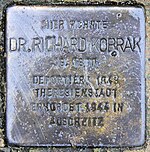Richard Kobrak
Richard Kobrak (born October 15, 1890 in Breslau ; died October 1944 in Auschwitz ) was a German social politician.
Life
Richard Kobrak was the son of the physician Georg Kobrak (1864-1937) and Jenny Wohlauer (1866-1942), who were Jews who had converted to Protestantism. He attended the Johannesgymnasium Breslau and studied law and political science at the Universities of Breslau, Freiburg im Breisgau and Munich. He received his doctorate in 1912 with a dissertation on the right to surrender in Breslau. He did his legal clerkship in the district of Glatz in Reinerz . Kobrak was a soldier in World War I from 1914 to 1918.
From 1919 to 1927 he worked as a lawyer in the city administration of Wroclaw, most recently in the rank of senior magistrate. He married the teacher Charlotte Stern (1893–1944), a daughter of the physician Richard Stern and aunt of the historian Fritz Stern , they had three children, Käthe Toni (born 1918), Helmut Richard (born 1920) and Eva Maria (born 1922) .
1928 joined as General Councilor in welfare and youth office in the municipal administration of the city of Berlin. In addition to coordinating social work in the city districts, he was responsible for questions of principle. Kobrak worked in the social committee of the German Association of Cities (DST), was a member of the main committee of the German Association for Public and Private Welfare (DV) and was a lecturer at the Social Women's School of the Inner Mission Berlin and a board member and lecturer at the German Academy for social and educational women's work .
After the handover of power to the National Socialists in 1933, he was initially dismissed, but then had to be reinstated due to the frontline fighter privilege . He was deported to the tax authorities in April 1935, and on January 1, 1936, he was forced to retire under the Nuremberg Laws . In 1935 Richard and Charlotte Kobrak joined the Confessing Church . During the November pogroms in 1938, Kobrak went into hiding for a short time in order to escape the terror of the German persecution of the Jews. As parents, they made sure that the three children were brought to a relative safety with Kindertransport to England, the two daughters survived the war in England, the son in Australia.
From 1937 Kobrak worked for Heinrich Spiero , who had set up an aid agency for full Christian Jews . In 1939, the work was transferred to Pastor Grüber's office . The Kobrak couple did not have their own immigration papers for the United States in their hands until the borders were finally closed in 1941. In 1940 he was obliged to work at Siemens-Schuckertwerke , they lost their apartment and they were assigned a room in a Jewish apartment . In March 1943 they were deported to the Theresienstadt ghetto . From there he was transported to the Auschwitz concentration camp on October 16, 1944 , where he was murdered. His wife came to Auschwitz in another transport and was also murdered.
Fonts (selection)
- The connection of the surrender claim with the claim for damages in the event of non-surrender . Leipzig, 1912
- Public welfare and its relationship with social security . Berlin: Association of German Health Insurance Officials and Employees, 1929
literature
- Peter Reinicke : Kobrak, Richard , in: Hugo Maier (ed.): Who is who of social work . Freiburg: Lambertus, 1998 ISBN 3-7841-1036-3 , p. 313f.
- Hartmut Ludwig: Richard Kobrak , in: Harald Schultze , Andreas Kurschat. With the collaboration of Claudia Bendick (ed.): "Your end looks at ...": Protestant martyrs of the 20th century . Leipzig: Evangelische Verlagsanstalt, 2006 ISBN 978-3-374-02370-7
- Anders Rydell: The Book Thieves: The Nazi Looting of Europe's Libraries and the Race to Return a Literary Inheritance . New York: Viking, 2017
Web links
- Literature by and about Richard Kobrak in the catalog of the German National Library
- Initiative Steglitz: Richard Kobrak , at stolpersteine-berlin
Individual evidence
- ↑ 2015 a book from the library of Richard Kobrak could be returned , at Central and Regional Library Berlin
| personal data | |
|---|---|
| SURNAME | Kobrak, Richard |
| BRIEF DESCRIPTION | German social politician |
| DATE OF BIRTH | October 15, 1890 |
| PLACE OF BIRTH | Wroclaw |
| DATE OF DEATH | October 1944 |
| Place of death | Auschwitz concentration camp |


